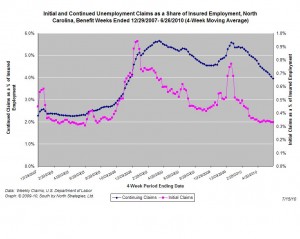16.07.2010
News Releases, Policy Points
CHAPEL HILL (July 16, 2010) – The June employment report for North Carolina is another in a series of unimpressive 2010 reports. Last month, the state added 5,100 more payroll positions than it lost. Although the private sector netted jobs, reductions in government payrolls – reductions linked primarily to the ending of temporary census positions – offset the bulk of the gains.
“The June employment report is another unimpressive report,” says John Quinterno, a principal with South by North Strategies, Ltd., a research firm specializing in economic and social policy. “Private payrolls grew, but many of the gains were offset by cuts to public-sector payrolls. The bottom line is little change.”
In June, employers added 5,100 more positions than they eliminated. The private sector netted 11,600 positions with hiring in leisure and hospitality services accounting for 68 percent of the total. Among private industries, leisure and hospitality services gained the most positions (+7,900), followed by professional and business services (+5,700), and manufacturing (+2,000). Those gains were offset by losses in construction (-1,600) and trade, transportation, and utilities (-1,200). Moreover, private-sector gains were offset by a loss of 6,500 public-sector positions, primarily temporary census-related ones.
Additionally, a revision to the May data raised net payroll growth for that month from 12,900 to 24,100; some 46 percent of the additional positions were in the public sector. Accounting for that revision, North Carolina has shed, on net, 238,100 positions or 5.7 percent of its payroll employment base since December 2007.
“Last month, payroll employment grew roughly in line with what is needed to accommodate population growth,” notes Quinterno. “The underlying dynamics, however, do not suggest that North Carolina’s job gap will close anytime soon.”
Labor market conditions have remained fairly flat over the past year. Compared to June 2009, the state had 29,800 more jobs (0.8 percent). In terms of individual industries, government grew the most in actual (+40,200) and relative terms (+5.7 percent). Among private industries, professional and business services added 20,700 more positions than it lost, while education and health services gained 10,700 positions. Construction (-20,300) and manufacturing (-13,300) lost the greatest number of positions over the past year with construction declining the most in relative terms (-10.6 percent).
June’s household data were particularly troubling. Last month, the labor force contracted by 0.6 percent as 26,025 individuals stopped working or seeking work. The number of employed individuals fell, as did the number of unemployed individuals. Due largely to the contraction of the labor force, the unemployment rate fell from 10.4 percent to 10 percent. The reduction in the size of the labor force is disturbing and suggests that joblessness is much more widespread than reflected in official measures.
“Overall, the June employment report contained some positive findings,” observes Quinterno. “Private-sector hiring was higher relative to recent months, and manufacturing employment appears to have stabilized. Unfortunately, a reduction in public-sector employment cancelled out many of those gains, resulting in an unimpressive report. And the reduction in the size of the labor force is alarming.”
“The June report may offer a preview of what is in store for the rest of 2010,” cautions Quinterno. “The private-sector payroll gains are welcome, but it is too soon to know if they are sustainable trends or data blips. Also, the expiration of public policy supports like temporary census hiring may serve as a drag on growth and negate any modest improvements that occur elsewhere in the economy.”
16.07.2010
Policy Points
In recent testimony before the Budget Committee of the U.S. House of Representatives, Mark Zandi of Moody’s Analytics summarized current economic conditions.
This dramatic turnaround is largely due to the aggressive and unprecedented response of monetary and fiscal policy. The Federal Reserve Board has implemented an effective zero interest rate policy and made a wide range of efforts to support the flow of credit throughout the financial system …. And under both the Bush and Obama administrations, Congress passed a series of fiscal stimulus efforts ranging from expanded benefits for unemployed workers to aid for state and local governments to tax cuts for businesses and households. While the effectiveness of any individual aspect of the policy response can be debated, there is no question that the overall policy response has been very successful.
—
Despite the enormous economic progress, the economy is not yet out of the woods. Unemployment is stuck near double digits, and the current rate of job growth is barely sufficient to forestall further increases in unemployment as population and the labor force grow. Though stock prices have rallied and house prices are more stable, household nest eggs have been significantly diminished. Confidence also remains fragile: Consumers and small businesses feel better than they did a year ago but no better than in the depths of past recessions. The recovery thus remains vulnerable if anything further goes wrong, and there is plenty to be nervous about ….


 Email Sign-Up
Email Sign-Up RSS Feed
RSS Feed